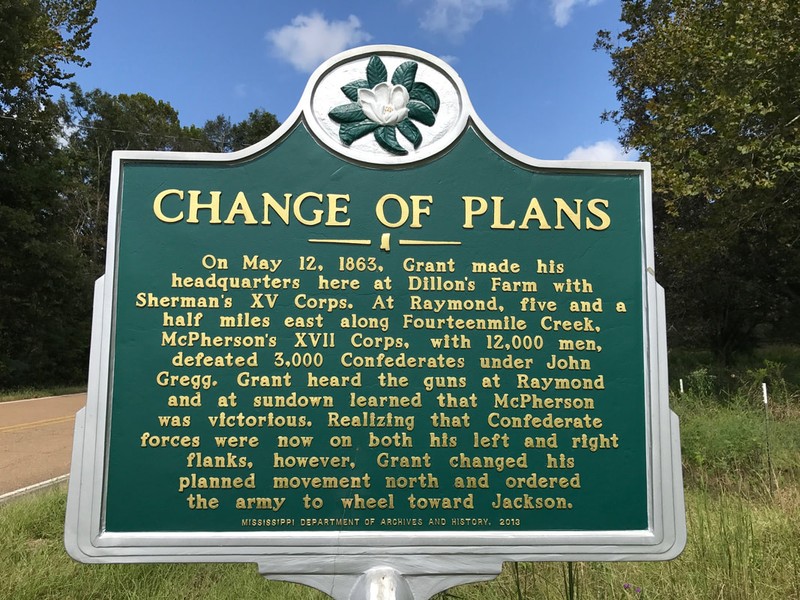Dillon's Plantation
Introduction
Text-to-speech Audio
Images
This historical marker is situated along the road next to site of Dillon's Plantation, where General Grant made the decision to attack Jackson. The Union victory isolated Vicksburg and led to its eventual capture.

Backstory and Context
Text-to-speech Audio
The Vicksburg Campaign began in late December 1862. As noted above, capturing Vicksburg was an important goal for the Union. It was the last major Confederate stronghold on the Mississippi River and seizing it would give the Union the ability to conduct trade in the Gulf of Mexico and transport troops and supplies more easily.
From late December 1862 to March 1863, all of Grant's attempts at taking Vicksburg failed. He planned a two-pronged attack where his forces would approach the city from the north through the Mississippi Delta marshes and from the west. Due to a number of factors, this plan, which included a series of maneuvers and building two canals just to the west of the city, ultimately failed.
Grant was undeterred, however, resuming the effort to take Vicksburg in late March. He sent troops down the west side of the river and ordered a flotilla of naval vessels carrying supplies south past the city to where the army planned to cross the Mississippi. In late April, Union and Confederate forces began a series of battles that tightened the Union's grip on the city. These included the aforementioned Battle of Raymond and the Battle of Jackson. The Union attack on Jackson was a total surprise to the Confederates, who were severely outnumbered. The city was not only the state's capital, it was where the railroads connecting to Vicksburg were located. Capturing the city prevented Confederate reinforcements and supplies from reaching Vicksburg. The Confederates were defeated again at the Battle of Champion's Hill (northwest of Raymond) on the 14th and the Union continued its push towards Vicksburg.
In recent times, Dillon's Plantation was known as Bailey's Farm. In 2003, it was acquired by the National Park Service and became part of the Natchez Trace Trail. A historical marker is located along the road next to the property. None of the original Dillon Plantation buildings remain but there are several modern structures still standing, including the Bailey Farmhouse. As of early 2021, it is unclear whether any significant improvements to the site have been made.
Sources
"Battle of Jackson (May 14)." National Park Service - Vicksburg National Military Park. Last Updated February 15, 2018. Accessed January 26, 2021.
"Battle of Raymond (May 12)." National Park Service - Vicksburg National Military Park. Last Updated February 15, 2018. Accessed January 26, 2021. https://www.nps.gov/vick/learn/historyculture/raymond.htm.
"Campaign for Vicksburg." National Park Service - Vicksburg National Military Park. Last Updated September 20, 2019. https://www.nps.gov/vick/learn/historyculture/campaign-for-vicksburg.htm.
"Change of Plans." Mississippi Markers. Accessed January 26, 2021. https://www.mississippimarkers.com/hinds-county-outside-jackson.html.
Drake, Rebecca & Hills Parker. "Dillon's Plantation Witnesses History Again." Battle of Raymond. 2003. http://battleofraymond.org/history/dillon.htm.
"Natchez Trace Parkway Acquires 470-Acre Bailey Farm." National Park Service. 2003. http://npshistory.com/publications/natr/bailey-farm-news.pdf.
Giambrone, Jeff T. "A Murderous Fire on my Whole Line: Two Battles at Jackson, Mississippi." Mississippians in the Confederate Army. September 14, 2013. https://mississippiconfederates.wordpress.com/2013/09/14/a-murderous-fire-on-my-whole-line-two-battles-at-jackson-mississippi.
Mississippi Markers
